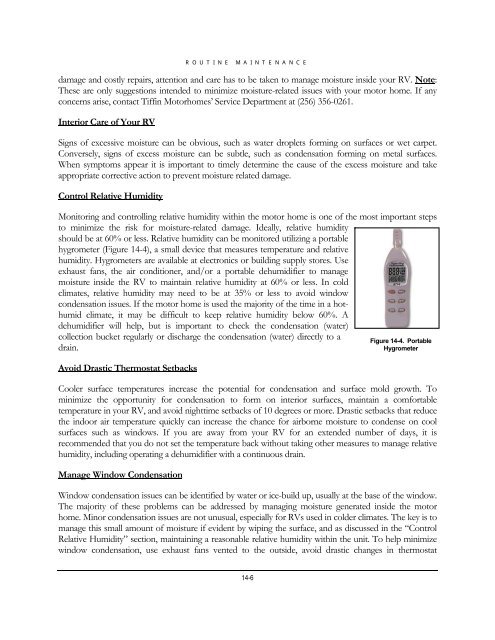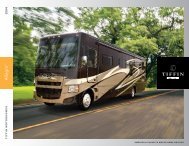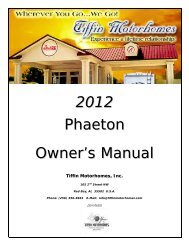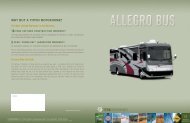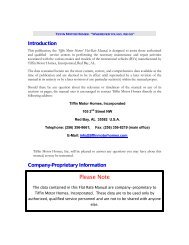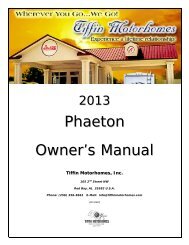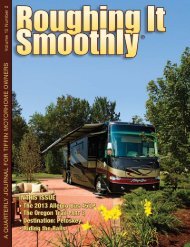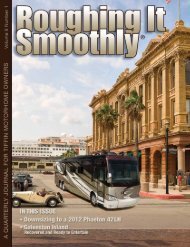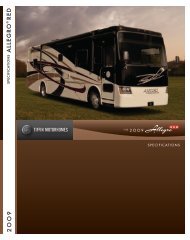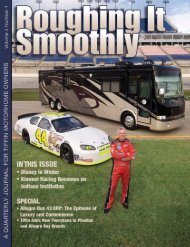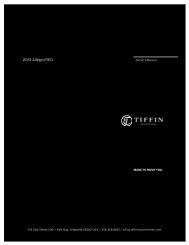Allegro Bay Owner's Manual - Tiffin Motorhomes
Allegro Bay Owner's Manual - Tiffin Motorhomes
Allegro Bay Owner's Manual - Tiffin Motorhomes
You also want an ePaper? Increase the reach of your titles
YUMPU automatically turns print PDFs into web optimized ePapers that Google loves.
ROUTINE MAINTENANCEdamage and costly repairs, attention and care has to be taken to manage moisture inside your RV. Note:These are only suggestions intended to minimize moisture-related issues with your motor home. If anyconcerns arise, contact <strong>Tiffin</strong> <strong>Motorhomes</strong>’ Service Department at (256) 356-0261.Interior Care of Your RVSigns of excessive moisture can be obvious, such as water droplets forming on surfaces or wet carpet.Conversely, signs of excess moisture can be subtle, such as condensation forming on metal surfaces.When symptoms appear it is important to timely determine the cause of the excess moisture and takeappropriate corrective action to prevent moisture related damage.Control Relative HumidityMonitoring and controlling relative humidity within the motor home is one of the most important stepsto minimize the risk for moisture-related damage. Ideally, relative humidityshould be at 60% or less. Relative humidity can be monitored utilizing a portablehygrometer (Figure 14-4), a small device that measures temperature and relativehumidity. Hygrometers are available at electronics or building supply stores. Useexhaust fans, the air conditioner, and/or a portable dehumidifier to managemoisture inside the RV to maintain relative humidity at 60% or less. In coldclimates, relative humidity may need to be at 35% or less to avoid windowcondensation issues. If the motor home is used the majority of the time in a hothumidclimate, it may be difficult to keep relative humidity below 60%. Adehumidifier will help, but is important to check the condensation (water)collection bucket regularly or discharge the condensation (water) directly to adrain.Avoid Drastic Thermostat SetbacksCooler surface temperatures increase the potential for condensation and surface mold growth. Tominimize the opportunity for condensation to form on interior surfaces, maintain a comfortabletemperature in your RV, and avoid nighttime setbacks of 10 degrees or more. Drastic setbacks that reducethe indoor air temperature quickly can increase the chance for airborne moisture to condense on coolsurfaces such as windows. If you are away from your RV for an extended number of days, it isrecommended that you do not set the temperature back without taking other measures to manage relativehumidity, including operating a dehumidifier with a continuous drain.Manage Window CondensationFigure 14-4. PortableHygrometerWindow condensation issues can be identified by water or ice-build up, usually at the base of the window.The majority of these problems can be addressed by managing moisture generated inside the motorhome. Minor condensation issues are not unusual, especially for RVs used in colder climates. The key is tomanage this small amount of moisture if evident by wiping the surface, and as discussed in the “ControlRelative Humidity” section, maintaining a reasonable relative humidity within the unit. To help minimizewindow condensation, use exhaust fans vented to the outside, avoid drastic changes in thermostat14-6


